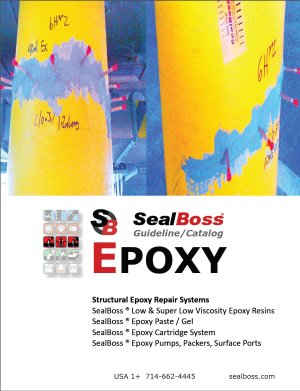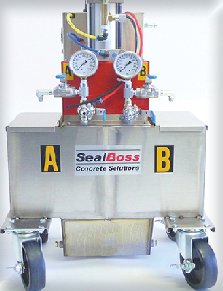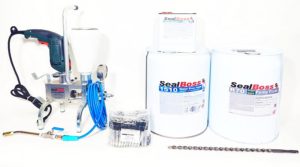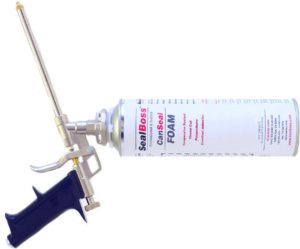DataPort System Crack Injection Performance Test

Table of Contents
DataPort System 1-3-2 POI Injection Test
Overview
Leak-sealing applications prove to be among the most challenging concrete repair projects in the industry. Extreme hydrostatic conditions sometimes create reoccurring leaks – even after seemingly successful chemical injection. Vague success indicators can cause costly contractor remobilization costs. Warranty work can also create disruptive and unanticipated client facility down-time.
Because of these considerations, SealBoss Corporation has developed a product and and application quality control system to determine chemical grouting leak sealing effectiveness.
The test is performed at the most critical point of injection — the predetermined port-to-port travel point — the farthest distance from the port of injection deemed to be reliable to create a permanent seal.
Non-Invasive, In Sequence POI Testing – No Additional Drill Holes Required
Why do we call it non-invasive?
Unlike other tests, the SealBoss DataPort System has been designed to not require additional drill holes, but to utilize the regular POI injection pattern and port-to-port travel injection standard to test the leak sealing performance.
The injection procedure pattern follows the 1-3-2 POI Test/Inject Sequence System.
The DataPort System injection/test procedure follows involves three injection packer locations.
During step one and two injections are performed at packer one and packer three in sequence, following the port-to-port injection guideline. Port-to-port travel describes the injection procedure where product travels from the injection port to the next ports in sequence during the injection procedure. Port-to-port travel is important to achieve effective water stop and leak sealing injection results. According to the guideline, during the injection of packer one, product must be observed at packer two before moving on to packer three. Packer two is omitted — serving as the Data Port for the test.
During step three in sequence, prior to subsequent injection, the test is now performed with the injection packer in place. For a good result, any cured product must be removed from the drill hole prior to testing.
The test has been designed to detect potential leaks at the most vulnerable points (port-to-port travel points) during or after injection without the need for additional drill holes into the substrate.
With the DataPort System testing method, additional drill holes that don’t serve the injection process are not necessary.
On the Job Testing Limitations
Testing the effectiveness of crack injection by standardized methods is limited when used in real life job applications. A test can deliver spot check data that needs to be interpreted based on the conditions on the jobsite. Outside the lab, the distribution pattern and effectiveness of leak seal product in the substrate cannot be tested in its entirety. A test is considered a spot check, covering the immediate area of the test. Even if the test indicates the leak seal to be adequate, it cannot provide reliable data for the whole injection project.
On the Job Non-Invasive Testing Advantages
Notwithstanding the limitations, a sequential spot test and the resulting interpretation is a tool to determine the injection method, product and equipment choices and to assess injection results at the test area. The results may not reliably be representative for the injection performance in its entirety.
The SealBoss DataPort System aims to provide the chemical grouting industry a QC system that can improve chemical grouting effectiveness, and save costs for both contractors and clients.




























